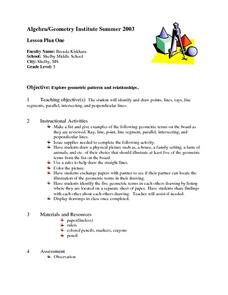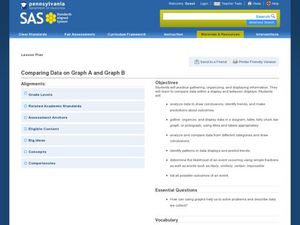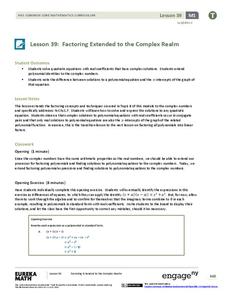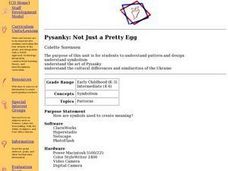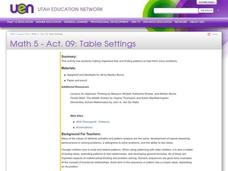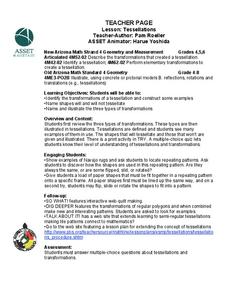Curated OER
Transformations and Exponential Functions
Tenth graders study graphing exponential functions. In this transformations lesson, 10th graders apply inquiry to determine how changes to a parent function affect its graph. Students analyze transformed graphs and generate the function...
Curated OER
Symmetry, Similar & Congruent Shapes
Fifth graders identify lines of symmetry., similar and congruent shapes. They use construction paper to create their own symmetrical shapes. Students create stained glass frames containing symmetrical, congruent and similar shapes.
Curated OER
Lesson Plan One: Points, Lines, Rays
Fifth graders explore basic geometric terms. Pupils draw a physical picture of a scene that illustrates at least five geometric terms. Partners exchange drawings and locate the illustration of geometric terms in the drawing.
Curated OER
Comparing Data on Graph A and Graph B
Second graders gather and graph data. For this graphing lesson, 2nd graders collect data and graph this information using tally charts, bar graphs, pictographs, or tables. They make predictions about the outcomes.
Curated OER
Tall Tale Rollers
Students explore American tall tales. In this tall tale lesson, students discover the six characteristics that are included in tall tales. Students survey their class to find each student's favorite tall tale character and organize the...
Curated OER
Solving a Legend- Exponents, Recursive and Explicit Equations.
Eighth graders play a game to solve problems. In this exponents and scientific notations lesson, 8th graders play a game in small groups to move colored disks from location A to location C. Students identify recursive patterns to solve...
Curated OER
Number Scrolls
Students write the number line. In this numbers instructional activity, students write numbers in numeric order on a number scroll. They find patterns within this number line.
Curated OER
The Little House
First graders read the story "The Little House" and discuss changing patterns and then create a seasonal mandala using a paper plate and crayons.
Curated OER
Guess That Sequence!
Pupils analyze number sense by participating in a pattern identification activity. In this number sequence lesson, students examine several groups of numbers and identify the sequence in the group before adding on to it. Pupils check...
EngageNY
Factoring Extended to the Complex Realm
A solution will work one way or another: find solutions, or use solutions to find the function. Learners use polynomial identities to factor polynomials with complex solutions. They then use solutions and the Zero Product Property to...
EngageNY
Logarithms—How Many Digits Do You Need?
Forget your ID number? Your pupils learn to use logarithms to determine the number of digits or characters necessary to create individual ID numbers for all members of a group.
Curated OER
Beep, Beep, Vroom, Vroom
Students practice identifying, creating and labeling simple patterns. They recreate patterns in used in Stuart Murphy's book, Beep, Beep, Vroom, Vroom.
Curated OER
Make-Your-Own Math Practice
Students create their own math practice book. In these homemade book lessons, students create their own counting, number, and shape pages. When the pages are complete, they are bound together in a book.
Curated OER
Classroom Idea: Clap Along
Students study patterns. In this math lesson, students repeat a pattern that has been clapped out by the teacher. Actions can be added to increase difficulty level.
Curated OER
Geometric Patterns and Relationships
Fifth graders explore three-dimensional figures. As a class, they discuss the characteristics of various three-dimensional figures. In groups, 5th graders write riddles describing the geometric shape. Partners read each other's...
Curated OER
Kindergarten Math Counting
Students practice their counting skills. In this counting practice lesson, students count from one to five orally, write the numbers through five independently, identify the numbers, and use macaroni for a hands on counting activity.
Curated OER
Geo Jammin' By DeSign - Day 2, Lesson 11: A Stitch in Time
Students investigate the culturally artistic value of quilts, the importance of trade in meeting basic needs, and the conservation of natural resources.
Curated OER
Pysanky: Not Just a Pretty Egg
Students examine the art of Pysanky. Using the Internet, they identify the cultural similarities and differences between the United States and the Ukraine. Using Pysanky's art, they discover the symbolism he used in his artwork and...
Curated OER
Table Settings
Fifth graders explore and examine how to make organized lists and find patterns to help them solve problems. They identify, analyze and determine a rule for predicting and extending numerical patterns involving operations of whole...
Curated OER
Tessellations
Students form repeating patterns using tessellations. In this tessellations lesson, students identify shapes and illustrate three types of transformations. A website is included with the lesson which provides extension activities and...
Curated OER
"Adding It Up" at James Fort
Students discuss jettons and their archaeological importance at Jamestown. They then practice using historic counting sheets and artifacts to understand the calculating methods of the early 17th Century, and identify their similarities...
Curated OER
Designing a Quilt Pattern
Students create and color a one-patch quilt design based upon a regular hexagon. They examine quilts and photos of quilt designs, read a handout, and complete their quilt design on a worksheet.
Curated OER
Gingerbread Baby
Students explore gingerbread stories. In this poetry lesson, students read the folk tale "The Gingerbread Man" as well as Gingerbread Baby by Jan Brett and identify rhyming words. Students also make art projects, dramatize the stories,...
Curated OER
Fibonacci Numbers
Students calculate the Fibonacci sequence of numbers. Through the use of Fibonacci numbers in flowers, leaves, fruits, vegetables, pine cones, and other forms of nature; students explore how Fibonacci numbers occur in nature. Then they...


